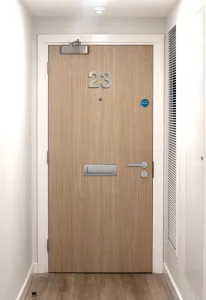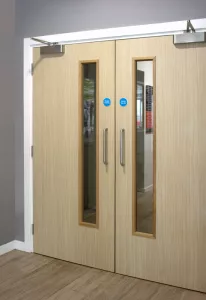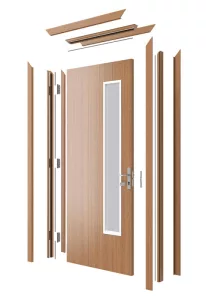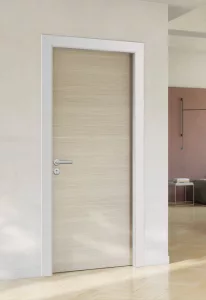Architectural trends in door design!
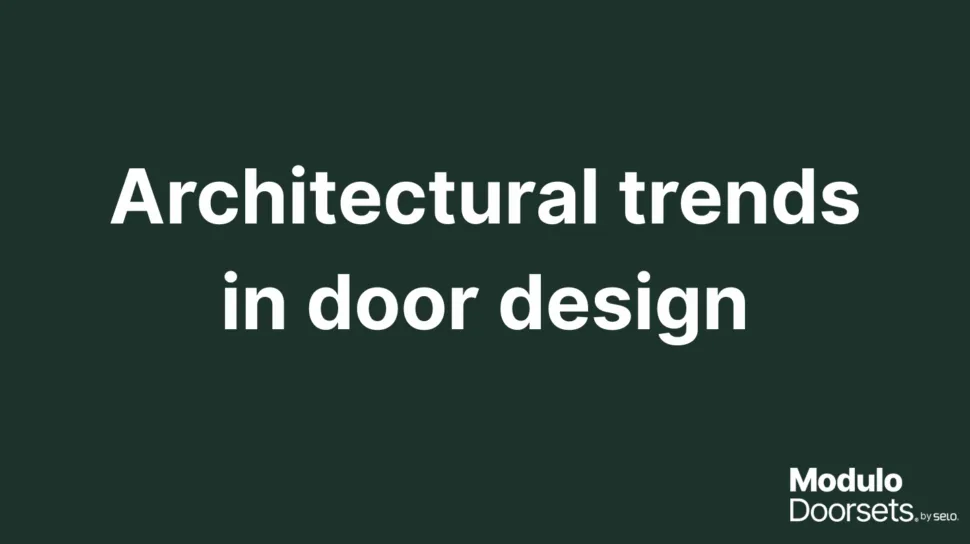
Each year, trends are always changing for interiors, and this includes the interior doors and the designs, as these will play a crucial part in the interior design. In the architectural world, doors are no longer just functional elements, doors are increasingly specified as parts of a space’s visual identity and performance strategy. This does include the fire rating of a doorset and ensuring it complies with the building’s standards. This article will explore the evolving trends in internal door design, not just surface-level styling, but the deeper shifts in materials, operation and use. At Modulo, we have a range of doorsets that can use any trend architects are looking for.
In the past year, we have seen a shift in the latest trends, especially across the commercial and high-end residential projects. Recently, we have seen a return of natural woodgrain and veneer finishes (especially in oak, ash and walnut). At Modulo, we can offer natural woodgrain finishes, including Latte and Butterscotch. We have also seen a return of tall, full-height doors for vertical emphasis. The minimal detailing has seen a rise in the last year. Flush-to-wall and concealed frame systems are gaining traction to help create the minimalist look in a building. A need for privacy in rooms is on the rise, fluted or reeded glass panels can be used to help create more privacy and light diffusion. We have also been seeing a demand for fire-rated doors that don’t look fire rated. A door offering both aesthetics and fire ratings, will be ideal for any architect for their project.
We have seen a shift in door design from blending in to now standing, architects want the doors to be seen throughout a project. There are many ways you can specify a door to ensure it stands out in the design. We have seen a rise of oversized doors, full-height panels and pivot formats. These architectural features will all help use the doors as statement elements in spatial composition. Visual detailing will also support the standout look, such as fluted timber, slimline profiles and cold shadow gaps.
In recent years, architects have been looking for high-spec doors as they are expected to perform without sacrificing the aesthetic. With speaking to architects, the rating of a door is now as important as aesthetics following the recent changes in the industry. Standard performance has become more important recently due to the evolving regulations and especially the changes to the building safety act, as an architect it is important to keep up with these changes. They are now wanting fire-rated doors or acoustic doors to integrate seamlessly into modern interiors. At Modulo, we are constantly finding new innovations to help keep up with architects needs.
Additionally, we have seen an increase in demand for intelligent door mechanisms, which is not just for aesthetic reasons, but for space efficiency and flow. This is all about the functionality of the door. We have seen a growing use of flush-to-wall doors for clean lines, pocket doors for spatial flexibility, and finally pivot doors.
As previously mentioned, architects are now favouring natural timber, reeded or fluted surfaces, matte finishes, integrated colour matching and warm colours like bronze or brass. Material choices will support broader interior movements. With this switch in the trend, we have launched a new range of finishes on top of standard finishes to help suit a range of interiors. We have brought out a range of natural colours, greys, light and ash finishes, so there is something for all interiors.
Finally, when planning a new project, the interior will now see a rise of adaptable doors, especially in apartments, co-working and hospitality environments. The Modulo doorset system has up to 25mm of adjustment in each dimension, ensuring perfectly-fitting doors in structural openings not perfectly formed. To help with multi-use spaces, architects can think to use sliding partitions, dual-purpose panels or doors that define space without fully closing it off. The flexibility of a door can be used as a tool for defining how a certain space will work, for example, if you need to split up office space.
Overall, to have a great door design, it doesn’t always depend on responding to the latest trends, it’s about anticipating how a space will feel and function over time, and if it will be suitable in the space it will be going into. Today, doors have become a critical part of interior architecture, balancing performance, detailing, and the aesthetic feel. At Modulo, we take pride in that we are the most forward-thinking manufacturer as we spend a lot of time working on new innovations to support the industry and ensure we understand the needs of architects.
If you would like to learn more about specifying the best door for your project or any questions on the types of doors, get in touch today!

